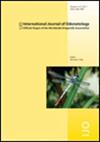蜻蜓的翅膀是如何工作的?简要介绍机翼结构部件的功能作用
IF 1
4区 农林科学
Q3 ENTOMOLOGY
引用次数: 20
摘要
昆虫的翅膀没有飞行肌肉,除了位于胸部的那些。然而,它们在飞行过程中不断地对作用在它们身上的力做出反应。这种能力是由机翼的专门设计实现的,在其空气动力学性能中起着关键作用。蜻蜓(异翅目)的翅膀是飞行昆虫中这种自动形状控制的一个极端例子。机翼的功能源于组成机翼的几个结构部件之间复杂的相互作用。本文结合近年来的研究成果,对翅脉、翅膜、翅脉微关节、翅脉结节、翅脉基底复合体和翅脉波纹等翅脉关键组成部分的功能作用进行了综述。我们的研究结果有助于理解复杂蜻蜓翅膀中每个机翼部件的结构,材料和功能之间的关系。我们进一步利用我们的数据来解释翅膀组件之间的相互作用如何为蜻蜓提供功能齐全的翅膀。本文章由计算机程序翻译,如有差异,请以英文原文为准。
How do dragonfly wings work? A brief guide to functional roles of wing structural components
Insect wings have no flight muscles, except those situated in the thorax. However, they continuously respond to forces acting on them during flight. This ability is achieved by the specialised design of the wings and plays a key role in their aerodynamic performance. Dragonfly (Anisoptera) wings represent an extreme example of this automatic shape control among flying insects. The functionality of the wings results from complex interactions between several structural components of which they are composed. Here we put together the results of our recent works, to review the functional roles of some of the key wing components including vein, membrane, vein microjoint, nodus, basal complex and corrugation. Our results help to understand the relationship between the structure, material and function of each of these wing components in complex dragonfly wings. We further use our data to explain how the interactions between the wing components provide dragonflies with fully functional wings.
求助全文
通过发布文献求助,成功后即可免费获取论文全文。
去求助
来源期刊

International Journal of Odonatology
ENTOMOLOGY-
CiteScore
2.30
自引率
0.00%
发文量
15
审稿时长
>12 weeks
期刊介绍:
International Journal of Odonatology (IJO) is aimed at providing a publication outlet for the growing number of students of Odonata. It will address subjects such as the ecology, ethology, physiology, genetics, taxonomy, phylogeny and geographic distribution of species. Reviews will be by invitation, but authors who plan to write a review on a subject of interest to the journal are encouraged to contact the editor.
 求助内容:
求助内容: 应助结果提醒方式:
应助结果提醒方式:


